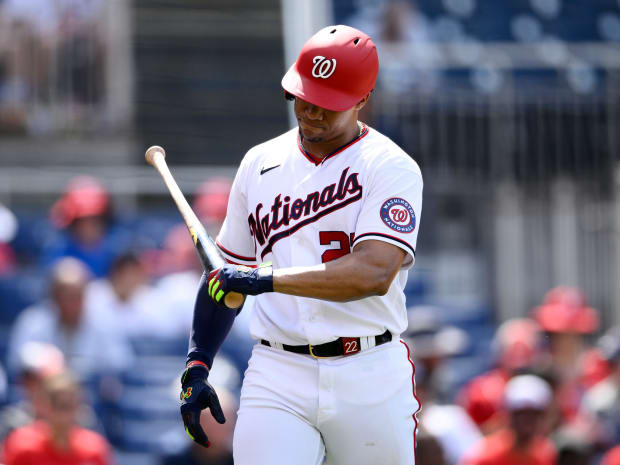Welcome to The Opener, where every weekday morning during the regular season you’ll get a fresh, topical story to start your day from one of SI.com’s MLB writers.
The baseball world is full of statistical anomalies. Paul Goldschmidt is slugging .687 against sliders. Max Muncy is hitting .147 against fastballs. Shohei Ohtani has bumped the velocity on his fastball by 2.6 mph. Martín Pérez has thrown 464 consecutive sinkers without allowing a home run since last September. Major league catchers are hitting .223—the worst ever.
But no fact is more surprising this year than this: Juan Soto is the worst hitter in baseball against breaking pitches. Entering Sunday, when he dumped a single into left field off a slider from Rangers righthander Glen Otto, Soto was hitting .067 against breaking pitches. He has five hits all season against spin.

AP Photo/Nick Wass
What in the name of Ted Williams, his historical comp for being this good this young, is going on with the 23-year-old Soto? His slash line of .218/.372/.436 represent career lows.
• His exit velocity is down 3.3 mph, the fifth-biggest decline in baseball.
• His chase rate is up 6.6 percentage points, tied for the 10th biggest increase.
• He is swinging less than ever at pitches in the zone.
• He is seeing many more shifts. Soto sees shifts 61% of the time, up from 44% last year, his previous high.
• The shifts and lower exit velo have cut his batting average on balls in play from .332 to .215.
• Pitchers generally avoid him. The Rangers threw Soto 24 pitches Sunday. Only six were in the strike zone. He walked four times. He has 48% more walks than anybody else in baseball over the past two seasons.
Are baseball fans missing the prime of a great young hitter because of spin and walks? Spin is Soto’s biggest problem. Entering this season Soto was a .245 career hitter against spin, well above the MLB average of .215. Nationals hitting coaches Darnell Coles and Pat Roessler have encouraged Soto to “back up the ball a little longer”—that is, concentrate on hitting the ball a little deeper to prevent him from getting out front on breaking pitches, which causes him to chase.
“He is getting a lot of breaking balls, especially in what he considers hitters’ counts,” manager Dave Martinez says. “So we’re trying to get him to back the ball up.
“With that being said, always be ready for the fastball. He’s been caught a little in between. He knows he’s getting a lot of breaking balls and he’s letting a lot of good pitches go by that he can hit. We’re trying to get him to understand, ‘Hey, you’re still a good fastball hitter. Get on the fastball, especially early in counts, and be ready for it.’”
The obvious narrative is that Soto must be seeing more spin and seeing fewer pitches in the zone because Washington has little support around him. The Nationals are 27–48 and rank 13th out of 15 NL teams in runs.
But Soto is seeing slightly less spin this year (29%) than he did in 2018 (31%) and ’19 (30%). And he’s seeing more pitches in the zone this year (46%) than he did in ’19 (44%) and ’20 (45%). Perhaps Soto is getting worn down by losing and the pressure to deliver hits for a weak offense? Over the past two years the Nats have the fourth-worst record in baseball, behind only Arizona, Baltimore and Pittsburgh.
“If he is struggling mentally, he doesn’t show it,” Martinez says. “I keep an eye on him. He’s the future of this organization. He’s the guy these guys are going to follow.
“He’s been good. He’s not hitting per se, and I say that and he’s got an .800 OPS. He’s always cheering for teammates. He’s working on his outfield play every day. He comes to play the game every day.”
Soto’s struggles really show up when he gets to two-strike counts. That’s when pitchers are feeding him spin out of the zone, and Soto uncharacteristically is chasing those pitches. He is 1-for-39 on two-strike spin.
Soto vs. Two-Strike Breaking Pitches
Soto is too good of a hitter to stay down this long. He may simply be fatigued by being pitched around so often. Over the past two seasons, Soto has walked 206 times. The next highest total is 139, by Joey Gallo. Since he stepped on a major league field May 20, 2018, Soto has seen more pitches called balls than any other hitter.
Soto has walked in 18.7% of his career plate appearances, more than double the major league average. That’s higher than the walk rate at age 23 for the three hitters with the most walks in history: Barry Bonds (11.2%), Rickey Henderson (14.6%) and Babe Ruth (11.3%). It’s right in line with the kind of avoidance that Williams saw at that age (18.9%).
Martinez is aware of the strain the walks and the losing can put on Soto. On the first day of this season, the manager walked up to Soto and asked him, “How do you perceive the game?” It was Martinez’s way of checking his baseball pulse, to see whether what drove Soto to be the pure hitter in the game still burned with the same intensity.
“And he looked at me and said, ‘Hey, I love baseball,’” Martinez says. “And I said, ‘Good. Don’t ever change that. When things go awry, just remember that.’”
This season is further challenging Soto, which is why Martinez periodically checks in on him by asking the same question.
“Hey, tell me something: What do you know about this game?” Martinez will ask him every now and then.
The answer is always the same. It has become their friendly ritual.
“I know I love baseball.”
“There you go,” Martinez will say. “Don’t change.”
Soto, and his patience, are being tested like never before.







